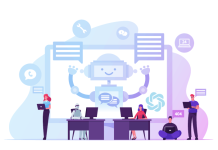
For all the buzz about “bots” and Artificial Intelligence (AI) and their potential to make agent-supported contacts go away, agent-handled contacts still dominate for many centers. Yet contact centers face labor markets that are not conducive to hiring and retaining great agents. Our Future of the Contact Center Survey put Robotic Process Automation (RPA—aka Agent Assistance) as the second “top technology” for CC’s of the future.
Here are some opportunities you might consider to transform your center with technology.
Agent training generally takes too long and overwhelms trainees with the complexity and diversity of customer interactions. So, ask yourself: Where does training get bogged down? What makes it take longer than you’d like? What overwhelms agents? What can we do to relieve the pressure?
If training does not prove an agent’s undoing, time to proficiency just might. It takes months for an agent to perform confidently to expected standards. Contact complexity and diversity play a major role here. But it’s also fueled by the difficulty in routing the “just right” contacts to the newbies. Fortunately, the same tools that make training easier could also pay dividends in accelerating agent proficiency and confidence.
Some tasks are tedious—the common, routine ones that still get to agents but could be handled by self-service if only the customer would use it. Think about how those repetitive, simple tasks could be made so much faster and easier for an agent if the system worked on their behalf.
Other tasks are complex, challenging and less common. The agent must spend more time trying to figure out the right process steps to follow and where to get information. Failing that, they end up escalating to a more seasoned resource, which isn’t good for anyone! Think about which elements of those more difficult contacts could be streamlined so that the agent could spend their time on problem-solving skills and a personal touch.
Sales opportunities often get missed by an overwhelmed agent or an increasingly impatient customer. A harried agent can easily skip an important step that might prevent a subsequent contact or ensure compliance. If you take the frustration out of the equation, how can you make it easy and convenient to complete all those “next steps?”
As you move from ideas to action, pursue process redesign with all the possibilities the new tools offer. Consider all channels—voice, email, chat, text, etc.—with an eye toward the end-to-end process that completes each transaction. (In other words, think about the full ecosystem, not just the contact center!)
Define how tools could work on behalf of your agents, customers and company. Handle the simple stuff with automated process steps. Provide pathways through the more difficult stuff (or more likely, parts of it) with faster/better access to the right information and guidance on what to do. Prompt for the additional input and consider the context to figure out whether to do something or escalate.
Seek RPA and/or business process management (BPM) tools to support your high-level design. Identify the various contact types and channels, and consider the integration points—KM, CRM, core systems.
Determine if you are going to make AI part of your process design—now or in the future. You may not need this technology for the simple stuff, but it can provide great value there or for complex interactions. Keep in mind, AI needs enough volume to make the investment worthwhile.
Determine if your process redesign and associated technology will tie into your self-service initiatives. Consider the interfaces, intelligence engines, and knowledge and data sources that agents tap and how they might be leveraged for self-service interactions. Invest time, resources, and budget in agent-handled contacts in proportion to the workload that they handle. Then work backwards to see if that investment can give a boost to self-service.
Define phases. Start simple, focusing attention on the easiest, biggest hitters that will deliver high value and let you learn quickly. Consider a proof concept before you get in too deep. Build on what you learn from implementing the PoC and initial phase(s).





